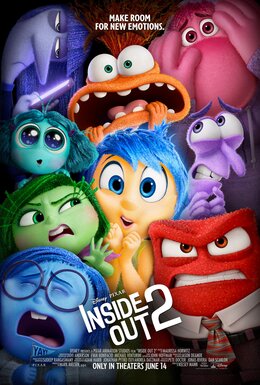 By Bob Garver
By Bob Garver
Back in 2015, Disney and Pixar introduced us to 11-year-old Riley and the squabbling emotions inside her prepubescent head. To make a long story short, Joy (Amy Poehler) tried to retain dominance over the girl, but Sadness (Phyllis Smith) kept creeping her way in. The struggle led to both emotions getting kicked out of Riley’s conscience. Following an adventure through the girl’s psyche, both emotions made their way back and Joy realized that she had to share Riley with other emotions, even unpleasant ones, in order for her to get the most out of life. In this new movie, Riley’s five core emotions want to retain dominance over the girl, but new emotions creep their way in. This leads to a struggle where the old emotions get kicked out of Riley’s conscience. They’ll have to go on an adventure through the girl’s psyche to make their way back and hopefully obliterate the new emotions. Or maybe they’ll learn to share and the message will be exactly the same as in the first movie.
For the record, I wasn’t a big fan of the first movie. Don’t get me wrong, I thought it was okay, and it kept the streak of at-least-passable Pixar alive until “Lightyear” two years ago. But setting up this elaborate world of personified emotions led to countless questions that the movie wasn’t prepared to answer, and without answering those questions, it didn’t make sense. Sometimes the nonsense played to its advantage, like a deus ex machina toward the end involving stackable crushes. Other times it hurt the movie, like leaving me wondering if these characters even had lives that were at stake, and what might happen to Riley if those lives were lost. The new movie raises more new questions than it answers, but this time I’m a little more comfortable knowing that the movie is prepared to answer some questions and not others.
For the new movie, Riley (Kensington Tallman) is going to hockey camp with her best friends Grace (Grace Lu) and Bree (Sumayyah Nuriddin-Green). Joy is looking forward to guiding her, along with core emotions Sadness, Anger (Lewis Black), Disgust (Liza Lapira), and Fear (Tony Hale). But Riley hits puberty the night before the camp, ushering in new emotions Anxiety (Maya Hawke), Envy (Ayo Edebiri), Embarrassment (Paul Walter Hauser), and Ennui (Adele Exarchopoulos). Anxiety proves useful in a few social situations, but clashes with Joy when the latter wants Riley to stay loyal to her old friends, as opposed to endearing herself to the more popular Val (Lilimar). The new emotions banish the old emotions to the back of Riley’s mind until she can be completely reworked.
My problem with the movie, other than that the story progression is pretty much the same as the first movie, is once again at the literal level. I can understand a kid with conflicting emotions, but what happens when a kid is missing five of them, as is the case here? If Riley is being controlled by the four new emotions, what’s making her competent at hockey? And why do the filmmakers think that Anxiety doesn’t manifest until puberty? What are young kids famous for saying on car trips? “Arewethereyet? Arewethereyet?” That’s Anxiety, guys.
Of course, just as the “Inside Out” movies teach audiences to take the bad with the good, I must remember to take the good with the bad. And there is a lot of good here. The animation is as colorful and delightful as ever, the emotional moments had me feeling for the characters, and the humor consistently hits. My favorite gags involve cartoon characters stuck in the back of Riley’s mind. Video game character Lance (Yong Yea) is another helpful crush of Riley’s, Pouchy (James Austin Johnson) is a little too happy to provide explosives, and Bloofy (Ron Funches) is a fourth-wall breaker with no fourth wall to break (you can practically hear the Disney writers saying, “Take that, Nickelodeon!”). These characters, more than the emotions, were the highlight of this passable Pixar affair.
Grade: B-
“Inside Out 2” is rated PG for some thematic elements. Its running time is 96 minutes.
Contact Bob Garver at rrg251@nyu.edu.




